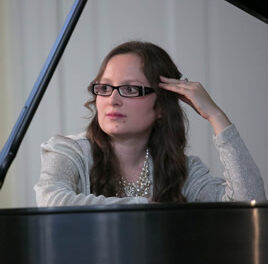An Italian word meaning “in a Gypsy style,” Zingaresca may not seem to be the ideal name for a Russian gypsy guitar duo, but once you hear the music of Vadim Kolpakov and Oleg Timofeyev in live performance, the name has a swaggering rightness to it. The duo’s “Secret of the Russian Gypsy Guitar” concert at the Belmont Abbey Basilica replicated the title of their 2017 CD and most of its content, with the added benefits of the basilica’s warm acoustics and Timofeyev’s spoken introductions. It was quickly apparent that “Roman Gypsy Guitar” has a double meaning, describing not only the music that Zingaresca performs but also the seven-string instruments that Kolpakov and Timofeyev play. While the dimensions of Kolpakov’s instrument are close enough to those of a classical instrument to spark an urge to count the tuning pegs on top of the neck, Timofeyev’s instrument is more novel, sporting a second fretless, lute-like neck, greater in length with six additional strings.
Apparently, Gypsy is too colloquial a term for the formal title of individual compositions in an Arts at the Abbey program leaflet – and Timofeyev does hold a doctorate from Duke University, after all – so the folk tunes in the concert lineup were called Romani Traditional. These were supplemented with compositions by Mikhail Vysotsky (1791–1837) and Tikhon Khrennikov (1913-2007). Arrangements for the two guitars were by Sergei Orekhov and Alexander Kolpakov, though it might be misleading to give the impression that it was all down on paper.
While Timofeyev had a music stand in front of him, donning a pair of reading glasses after he concluded each of his introductory remarks, Vadim was looking exclusively at the strings and fretboard of his guitar, no sheet music in sight when he accompanied or took the lead. Kolpakov was thus more likely to play the introductory cadenzas at the start of pieces, including “I Hear Your Voice Again,” “The Gypsies Were Traveling,” and the concluding “Gypsy Vengerka.” On perhaps the most unusual piece on the program, the traditional “Oriental Gypsy Dance ‘Are You Joking?,'” Kolpakov not only embroidered the intro but also upstaged Timofeyev’s solo with a variety of percussive knocks and cracks on the body of his guitar before taking back the instrumental lead with dazzling strums, rapid-fire runs, and a spray of harmonics.
Timofeyev also delivered impressive solos, seemingly without effort or frantic movement, especially on “Along the Kazanka River” and “A Nightingale,” but he seemed to take equal delight in setting the plodding two-step tempos of the dances, so redolent of the Zorba the Greek movie score and the Russian interlude in Fiddler on the Roof, and accompanying Kolpakov’s flights when he pushed the tempos. After a while, the delight of the slow emphatic openings to some of the pieces partly became the anticipation of the speed-ups to come. “Moscow Polka,” “The Godmother,” “Dance, Dzhandzha,” and the duo’s signature piece, “Zingaresca,” all displayed their special chemistry and characteristic tempo shifts.
Inevitably, the duo mentioned Django Reinhardt (1910-53) in their overview of Gypsy guitar, and the last two pieces on the program, “Moscow Windows” and “The Gypsy Vengerka,” certainly took jazzier flights. Neither tune had an arranger listed in the program, a sure tip-off that Kolpakov was feeling free to wail after invoking the Gypsy leader of the Quintette du Hot Club de France. “Moscow Windows” was particularly designed to burn from start to finish, but the final “Gypsy Vengerka” reverted to the Russian Gypsy guitar template, with Kolpakov establishing the lusty dance tempo this time. Here it wasn’t all about virtuosity, for when Kolpakov and Timofeyev quickened the tempo, they also injected sweet lyricism into their solos.
Editor’s Note: The Romani people are sometimes known as Gypsies – a term many of them view as pejorative – but the word gypsy can and often does also refer to certain ensembles and musical styles stemming from Central and Eastern Europe. In this review, no offense is intended or implied.











